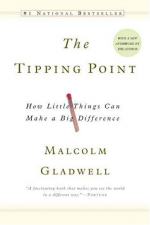|
This section contains 745 words (approx. 2 pages at 400 words per page) |

|
The Tipping Point Summary & Study Guide Description
The Tipping Point Summary & Study Guide includes comprehensive information and analysis to help you understand the book. This study guide contains the following sections:
This detailed literature summary also contains Topics for Discussion and a Free Quiz on The Tipping Point by Malcolm Gladwell.
In The Tipping Point, Gladwell follows trends from their inception to their end and tries to discover why some ideas "tip" and others do not. First, Gladwell gives the three rules for the tipping point: contagiousness; the fact that little causes can have big effects; and change happens in one moment.
In the opening chapter of the book, Gladwell uses the syphilis epidemic of Baltimore, along with other outbreaks of disease, to illustrate his three rules. He restates the three rules more simply as the law of few, the stickiness factor and the power of context.
In Baltimore in recent years, syphilis cases have spiked dramatically. Gladwell assumes that a few key infected persons spread the disease throughout the city. He cites documented cases of HIV spreading in just that manner, thus establishing the law of few. The stickiness factor inherently exists with disease outbreak, though cuts to public health clinics exacerbated the length of time people suffered with, and therefore spread, the disease. Finally, environmental circumstances served to spread the disease, such as limited healthcare and destruction of public housing.
In subsequent chapters, Gladwell expounds on the three rules, first dealing with the law of few. For his main example of this rule, he uses the midnight ride of Paul Revere. Gladwell classifies those people that contribute most to epidemics in three ways. These three ways are as connectors, those who know an unusual variety of people; as mavens, those people who make it a personal ambition to know and share a large variety of information; and as salesmen, those people who encourage others to try a new idea and make it almost impossible to resist. Gladwell proposes that when an idea comes to the attention of one or more of these special classes of people, the chance of the idea tipping increases.
Revere possessed attributes of each class. He made it his mission to know the movements of the British troops. Because he knew this, people constantly brought him more information, and he became an expert in the area. He also knew the countryside and knew important people in each village through which he rode. He connected the right people and told them the information he knew. Furthermore, he convinced them that his information required immediate action, thus sparking the battles in Lexington and Concord.
Gladwell's next law, the stickiness factor, discusses what small elements make or break a new idea. The children's television program Sesame Street serves as the central example for this section. Joan Gantz Cooeny desired to bridge the illiteracy gap of underprivileged children so she enlisted several technology experts and child psychologists. They developed an hour-long show of short skits geared towards improving literacy. After testing pilot shows, however, they discovered the need for a few changes. Foremost, they discovered children preferred for the human actors to interact with the puppets—known as "Muppets"—and other fantasy aspects. Such a small change illustrates the thin line between tipping and not tipping.
Environmental aspects influence the final rule, the power of context. The key example revolved around a subway shooting in New York City at a time when the subway suffered from much neglect and crime. When a group of young men attempt to mug Bernhard Goetz, he reacts in defense and shoots them, killing several. Experts involved in the later cleanup of the subway system cite small, environmental aspects such as petty theft and graffiti as contributing factors to this crime.
Such a theory is named the "broken window theory," which says that broken windows on a street encourage further vandalism, until the street becomes riddled with crime. City officials began to fight crime on the subways by painting over the graffiti, and keeping the system clean of vandalism religiously. The author returns to several, earlier examples to cite the importance of context there, such as the timing of Revere's ride, midnight.
The final chapters of the book give in-depth case studies, each of which illustrates one or more aspects of the tipping point. Suicide and teen smoking receive the most attention. On the subject of teen smoking, the author points out that cigarettes themselves do not draw young people to try smoking, but rather, the "coolness" of the stereotypical smoker. The smoker, therefore, becomes a salesman.
In conclusion, the author encourages his reader, pointing out that, if the laws in the book are true, which the examples support, change is always possible.
Read more from the Study Guide
|
This section contains 745 words (approx. 2 pages at 400 words per page) |

|



